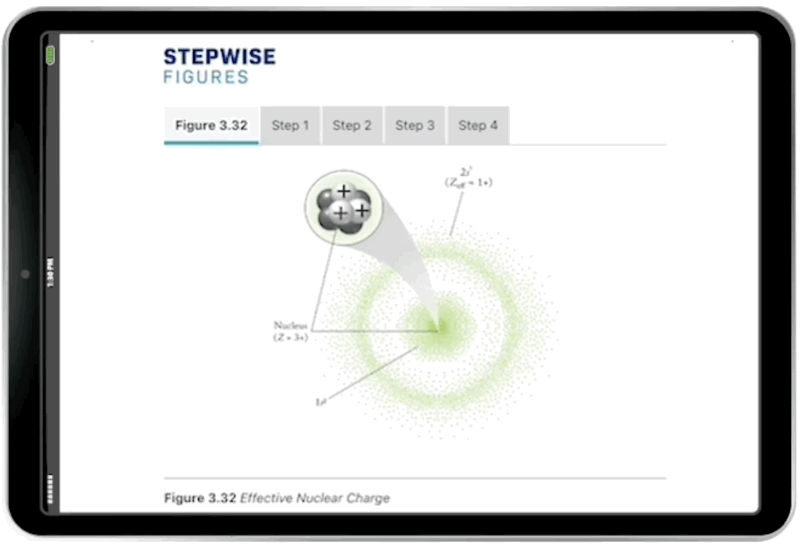
Help your students visualize chemistry—and their role within it.
With Chemistry: An Atoms-Focused Approach, students get an accessible, affordable, truly atoms-focused learning package that helps students of all backgrounds visualize chemistry while understanding its applications to future careers and research. In the exciting new Fourth Edition, new co-authors Carribeth Bliem and Anna Curtis (UNC-Chapel Hill) have brought a broad range of real-world career and research applications to the text and digital resources. These complement the visualization pedagogy from coauthor and Chemistry Education Researcher Stacey Lowery Bretz.
Features of the Fourth Edition

NEW Stepwise Figures
New to this edition, Stepwise Figures demystify complex figures in the ebook by providing an order for students to digest the information and develop deeper, more holistic understandings of chemical principles with additional commentary from the textbook authors.

RE-IMAGINED Chemtour Animations
Written and designed by our textbook authors, ChemTours coach students through foundational concepts while providing rich, specific feedback with every answer to ensure that students have mastered each part of the lesson before moving forward. Their range of images, animations, and interactives give students a learning experience that is visually cohesive with the text’s research-backed art.

New co-authors
New coauthors Carribeth Bliem and Anna C. Curtis bring innovative pedagogy to the text and media from teaching thousands of general chemistry students at UNC-Chapel Hill. They bring a wealth of teaching experience and strategies that motivate students to overcome barriers to learning.
Meet the Authors
Thomas R Gilbert
has a BS in chemistry from Clarkson and a PhD in analytical chemistry from MIT. After 10 years with the Research Department of the New England Aquarium in Boston, he joined the faculty of Northeastern University, where he has taught undergraduate courses in general and analytical chemistry, and graduate courses in spectroscopy, electroanalytical chemistry, and science education. His administrative roles at Northeastern included Associate Director for Academic Affairs and Acting Dean of the School of Education. He has been an emeritus member of the faculty since 2023 with continuing research activity in chemical education. He is a fellow of the American Chemical Society, for which he has served as a Councilor and member of the Board of Directors.
Stacey Lowery Bretz
is the Dean of the Getty College of Arts & Sciences at Ohio Northern University where she holds the rank of Professor in the Department of Chemistry & Biochemistry. Her research investigates students’ learning of chemistry, with expertise in developing assessments of students’ thinking in the laboratory and with multiple representations of molecules and compounds. Dr. Bretz is a Fellow of the American Chemical Society (ACS), a Fellow of the American Association for the Advancement of Science, and was an American Council on Education Fellow in the Office of the Chancellor at the University of Illinois Urbana-Champaign. She earned her BA in chemistry from Cornell University, her MS from the Pennsylvania State University, a Ph.D. in chemistry education research (CER) from Cornell University, and completed a post-doc at the University of California, Berkeley in the Department of Chemistry.

Carribeth Bliem
earned her BS in chemistry from the University of Utah and her MS in chemistry from the University of Colorado at Boulder. She is a Teaching Associate Professor at the University of North Carolina at Chapel Hill, where she brings evidence-based practices of high structure active learning to the undergraduate classroom, both in General Chemistry and Physical Chemistry. Her instructional goals are to provide opportunity for students to think critically about problems, work collaboratively to find solutions, and connect chemistry to daily life. When not in the classroom, she studies factors that support student learning in large-enrollment courses, including classroom design and the use of undergraduate learning assistants.

Anna C. Curtis
is a Teaching Assistant Professor in the Department of Chemistry at the University of North Carolina at Chapel Hill. She earned her B.S. in chemistry from the University of North Carolina at Chapel Hill and her PhD in physical chemistry from the University of Colorado Boulder. The current focus of her research lies in undergraduate chemistry course assessment and reform with a focus on the efficacy of active learning strategies within different learning spaces. As both a teacher and a researcher, she is committed to incorporating current research and best practices in chemical education into her teaching and assessing their impact on student learning. Her interest in chemical education is driven by her belief that, with a growth mindset and an effective learning environment, all students are capable of learning chemistry.
Instructors: Receive Digital Access
What Students and Instructors are saying
“This book is better than a lot of others in integrating concepts from other chapters and other disciplines. It explains concepts with narratives instead of throwing in equations.”
Shuai Sun
University of Kansas
“The textbook aims to emphasize chemistry as the central science and relates the chemistry material to other knowledge extensively…. . I have been using it as a textbook for a few years and really like the teaching experience from both a teacher perspective and feedback from students.”
Haofei Zhang
UC Riverside
“It works very well as a benchmark for students who may not be super engaged in lecture. It’s an excellent stand-alone resource and helps us to keep a homogenized curriculum over the 10 or so people who teach gen chem every year.”
W. Hill Harman
UC Riverside











